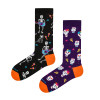Socks with skulls and skeletons
Our colorful skull socks and skeleton socks were inspired by Dia de Muertos. Mexico's oldest religious-ethnic holiday is known all over the world for its joyful atmosphere and distinctive skulls and fever of colors. Such a Day of the Dead is very different from our European customs, which are filled with sadness and melancholy. The origins of Dia de Muertos date back as far as 3,000 years and include Mayan and Aztec customs. Since 2008, the celebration of the Day of the Dead has been on UNESCO's list of Intangible Heritage Sites. Originally, the holiday was celebrated throughout August and was closely associated with the goddess Mictecacíhuatl, wife of the Ruler of the Land of the Dead. The figure of the Queen of Death is nowadays often identified with the image of La Catrina. Spanish conquistadors moved the date of the holiday to early November in an effort to eradicate pagan traditions. However, cultural identity proved stronger than external customs. The Mexican Day of the Dead is a joyous gathering of the living and the dead, the latter arriving home led by bunches of yellow velvets. It is celebrated primarily in two places - homes and graves. In homes, altars are erected in honor of the dead. Among other things, favorite dishes and drinks of relatives are set up, as well as objects related to them. The feast also continues at the cemetery, where there is an atmosphere of merriment. It's a time to talk about deceased relatives. As in Polish Dziady, here, too, intentionally dropped food is a treat for the dead.
Mexican skullcaps
Our socks with colorful skulls refer to one of the most distinctive elements of the Mexican Day of the Dead. Calaveras are referred to as decorative or edible skulls, which are made from sugar and clay, among other materials. The name also encompasses all artistic representations of Mexican skulls. The sugar skulls are placed on graves and altars to honor the dead during Dia de Muertos celebrations. In the pre-Columbian period, images of skulls and skeletons primarily symbolized a readiness for extraterrestrial life. In the 20th century, political cartoonist José Guadalupe Posada created drawings of skeletons dressed in the clothes of upper-class people. The most popular became La Catrina, who is considered a symbol and even personification of death. Characteristic elements of her image include a hat with feathers, a long dress and elegant shoes. In Mexican culture, death is considered the natural succession of life, so her images are not scary, and incorporate many patterns and colors to foreshadow eternal life. Calaveras resemble small works of art. It is estimated that artisans devote up to six months of their labor to produce and decorate skulls intended for one season. A wide selection of calaveras is available at local stalls about two weeks before Dia de Muertos.

